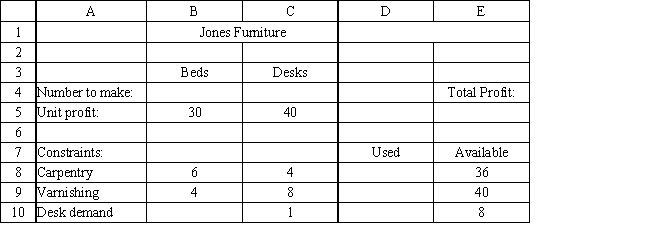Exhibit 3.1
The following questions are based on this problem and accompanying Excel windows.
Jones Furniture Company produces beds and desks for college students. The production process requires carpentry and varnishing. Each bed requires 6 hours of carpentry and 4 hour of varnishing. Each desk requires 4 hours of carpentry and 8 hours of varnishing. There are 36 hours of carpentry time and 40 hours of varnishing time available. Beds generate $30 of profit and desks generate $40 of profit. Demand for desks is limited, so at most 8 will be produced.  The LP model for the problem is
The LP model for the problem is 

-Refer to Exhibit 3.1. What formula should be entered in cell E5 in the accompanying Excel spreadsheet to compute total profit?
Definitions:
Confidence Interval
A variety of numerical values, obtained from statistical analysis of a sample, which probably includes the value of an unseen population characteristic.
Standard Deviation
A measure of the amount of variation or dispersion of a set of values, calculated as the square root of the variance.
Variance
A measure of the dispersion of a set of data points in a population, showing how much the data diverge from the average value.
Degrees of Freedom
The number of independent values or quantities which can vary in the calculation of a statistic, typically in the context of hypothesis testing.
Q13: The slope of the utility of wealth
Q14: Marylou, whose utility of wealth curve is
Q16: The goal of discriminant analysis is<br>A)to develop
Q21: Refer to Exhibit 9.3. What is the
Q37: John's utility of wealth curve is shown
Q55: Draw the network and solution for the
Q57: A diet is being developed which
Q101: Jimmy's utility of wealth schedule is given
Q163: John's utility of wealth curve is shown
Q168: If a life insurance company offers coverage